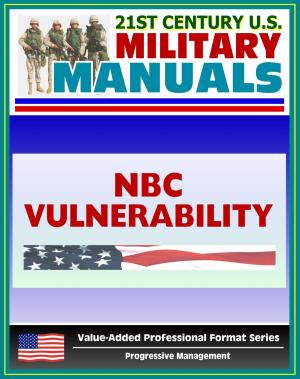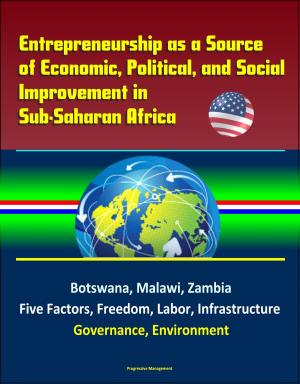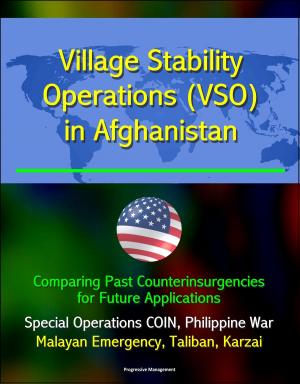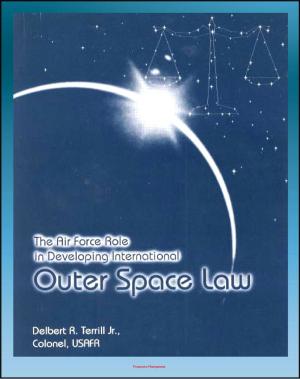Civil Military Engagements Program: A Special Operations Solution to Threats Derived from Undergoverned Areas - SOF and Civil Affairs in Pakistan, Sri Lanka, Horn of Africa, and Battle Against ISIS
Nonfiction, History, Military, United States| Author: | Progressive Management | ISBN: | 9780463400784 |
| Publisher: | Progressive Management | Publication: | May 3, 2018 |
| Imprint: | Smashwords Edition | Language: | English |
| Author: | Progressive Management |
| ISBN: | 9780463400784 |
| Publisher: | Progressive Management |
| Publication: | May 3, 2018 |
| Imprint: | Smashwords Edition |
| Language: | English |
This excellent report has been professionally converted for accurate flowing-text e-book format reproduction.
Arguably the most serious threats to United States (U.S.) national security, in both the current and future operating environments are terrorist or criminal non-state organizations. The 2015 National Security Strategy, 2014 Quadrennial Defense Review, and Army Operating Concept 2020-2040 clearly identifies these threats as the most complex problem that the U.S. Army will face. In 2014, Special Operations Command (SOCOM) requested further research to identify ways that Special Operations Forces (SOF) may effectively accomplish their objectives in undergoverned, threat areas. Using three regionally diverse examples, this thesis proposes that the Civil Military Engagements (CME) program, within the Civil Affairs (CA) Regiment, provides SOF an optimal solution to achieve its long-term objectives in undergoverned areas. This is initially due to their ability to gain and maintain access into targeted regions, and capitalizing on this access by filling information gaps and identifying sources of instability. However, the greatest value is its ability to serve as a vanguard for Department of State (DoS) efforts in assisting host nation governance.
ACRONYMS * ILLUSTRATIONS * TABLES * CHAPTER 1 INTRODUCTION * The Problem * Assumptions * Limitations * Delimitations * Conclusion * Definitions * CHAPTER 2 LITERATURE REVIEW * Operational Environment * Strategic Guidance * Geographic Combatant Commands * Special Operations Forces * Current Civil Affairs Education * Horn of Africa * Pakistan * Sri Lanka * Summary * CHAPTER 3 RESEARCH METHODOLOGY * CHAPTER 4 ANALYSIS * Horn of Africa * Mission and Primary Role * Vulnerability Assessments * Information Collection * DoS Synchronization * Horn of Africa Summary * Pakistan * Mission and Primary Role * Vulnerability Assessments * Information Collection * DoS Synchronization * Pakistan Summary * Sri Lanka * Mission and Primary Role * Vulnerability Assessments * Information Collection * DoS Synchronization * Sri Lanka Summary * Summary * CHAPTER 5 CONCLUSIONS AND RECOMMENDATIONS * Conclusion * Recommendations * Civil Affairs Organization * Special Operations Forces-Department of State Synchronization * Civil Information Management * Education and Training * Summary * APPENDIX A CONSENT TO PARTICIPATE IN A RESEARCH STUDY * APPENDIX B INTERVIEW QUESTIONS FOR SOF AND DoS PERSONNEL * APPENDIX C INTERVIEW QUESTIONS FOR IMSG AND CMAG * APPENDIX D SOF AND DoS INTERVIEW RESPONSES * APPENDIX E CMAG AND IMSG INTERVIEW RESPONSES * BIBLIOGRAPHY
This excellent report has been professionally converted for accurate flowing-text e-book format reproduction.
Arguably the most serious threats to United States (U.S.) national security, in both the current and future operating environments are terrorist or criminal non-state organizations. The 2015 National Security Strategy, 2014 Quadrennial Defense Review, and Army Operating Concept 2020-2040 clearly identifies these threats as the most complex problem that the U.S. Army will face. In 2014, Special Operations Command (SOCOM) requested further research to identify ways that Special Operations Forces (SOF) may effectively accomplish their objectives in undergoverned, threat areas. Using three regionally diverse examples, this thesis proposes that the Civil Military Engagements (CME) program, within the Civil Affairs (CA) Regiment, provides SOF an optimal solution to achieve its long-term objectives in undergoverned areas. This is initially due to their ability to gain and maintain access into targeted regions, and capitalizing on this access by filling information gaps and identifying sources of instability. However, the greatest value is its ability to serve as a vanguard for Department of State (DoS) efforts in assisting host nation governance.
ACRONYMS * ILLUSTRATIONS * TABLES * CHAPTER 1 INTRODUCTION * The Problem * Assumptions * Limitations * Delimitations * Conclusion * Definitions * CHAPTER 2 LITERATURE REVIEW * Operational Environment * Strategic Guidance * Geographic Combatant Commands * Special Operations Forces * Current Civil Affairs Education * Horn of Africa * Pakistan * Sri Lanka * Summary * CHAPTER 3 RESEARCH METHODOLOGY * CHAPTER 4 ANALYSIS * Horn of Africa * Mission and Primary Role * Vulnerability Assessments * Information Collection * DoS Synchronization * Horn of Africa Summary * Pakistan * Mission and Primary Role * Vulnerability Assessments * Information Collection * DoS Synchronization * Pakistan Summary * Sri Lanka * Mission and Primary Role * Vulnerability Assessments * Information Collection * DoS Synchronization * Sri Lanka Summary * Summary * CHAPTER 5 CONCLUSIONS AND RECOMMENDATIONS * Conclusion * Recommendations * Civil Affairs Organization * Special Operations Forces-Department of State Synchronization * Civil Information Management * Education and Training * Summary * APPENDIX A CONSENT TO PARTICIPATE IN A RESEARCH STUDY * APPENDIX B INTERVIEW QUESTIONS FOR SOF AND DoS PERSONNEL * APPENDIX C INTERVIEW QUESTIONS FOR IMSG AND CMAG * APPENDIX D SOF AND DoS INTERVIEW RESPONSES * APPENDIX E CMAG AND IMSG INTERVIEW RESPONSES * BIBLIOGRAPHY















